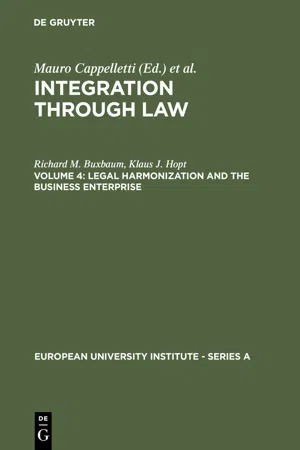
eBook - PDF
Legal Harmonization and the Business Enterprise
Corporate and Capital Market Law Harmonization Policy in Europe and the U.S.A.
This is a test
- 381 Seiten
- German
- PDF
- Über iOS und Android verfügbar
eBook - PDF
Legal Harmonization and the Business Enterprise
Corporate and Capital Market Law Harmonization Policy in Europe and the U.S.A.
Angaben zum Buch
Inhaltsverzeichnis
Quellenangaben
Häufig gestellte Fragen
Gehe einfach zum Kontobereich in den Einstellungen und klicke auf „Abo kündigen“ – ganz einfach. Nachdem du gekündigt hast, bleibt deine Mitgliedschaft für den verbleibenden Abozeitraum, den du bereits bezahlt hast, aktiv. Mehr Informationen hier.
Derzeit stehen all unsere auf Mobilgeräte reagierenden ePub-Bücher zum Download über die App zur Verfügung. Die meisten unserer PDFs stehen ebenfalls zum Download bereit; wir arbeiten daran, auch die übrigen PDFs zum Download anzubieten, bei denen dies aktuell noch nicht möglich ist. Weitere Informationen hier.
Mit beiden Aboplänen erhältst du vollen Zugang zur Bibliothek und allen Funktionen von Perlego. Die einzigen Unterschiede bestehen im Preis und dem Abozeitraum: Mit dem Jahresabo sparst du auf 12 Monate gerechnet im Vergleich zum Monatsabo rund 30 %.
Wir sind ein Online-Abodienst für Lehrbücher, bei dem du für weniger als den Preis eines einzelnen Buches pro Monat Zugang zu einer ganzen Online-Bibliothek erhältst. Mit über 1 Million Büchern zu über 1.000 verschiedenen Themen haben wir bestimmt alles, was du brauchst! Weitere Informationen hier.
Achte auf das Symbol zum Vorlesen in deinem nächsten Buch, um zu sehen, ob du es dir auch anhören kannst. Bei diesem Tool wird dir Text laut vorgelesen, wobei der Text beim Vorlesen auch grafisch hervorgehoben wird. Du kannst das Vorlesen jederzeit anhalten, beschleunigen und verlangsamen. Weitere Informationen hier.
Ja, du hast Zugang zu Legal Harmonization and the Business Enterprise von Richard M. Buxbaum, Klaus J. Hopt im PDF- und/oder ePub-Format sowie zu anderen beliebten Büchern aus Jura & Völkerrecht. Aus unserem Katalog stehen dir über 1 Million Bücher zur Verfügung.
Information
Inhaltsverzeichnis
- General Editors’ Foreword
- Acknowledgements
- Table of Cases
- Table of Constitutional, Treaty and Legislative Provisions
- List of Abbreviations
- Chapter One: Introduction - Models of Inquiry
- I. The Search for a Rational Division of Powers
- A. Quantitative Criteria
- B. Formal Criteria
- C. The Relevance of Constitutional Text and Context to the Choice of Criteria
- II. Economic Considerations Underlying the Division of Powers in the Field of Corporate and Enterprise Law
- A. The Public Choice Approach
- B. The Productivity of Integration Approach
- C. The Nature of the State and the Unification of Law
- III. The Political Frame of Reference
- A. The European Political Frame of Reference
- B. The American Political Frame of Reference
- IV. Conclusion
- Chapter Two: The American Experience
- I. Introduction
- II. The Factual Setting for the State Regulation of Trans-State and Transnational Company Activities: An Introduction and Census
- III. The American Constitutional Framework of Corporation Law
- A. Introduction
- B. Division of Powers
- C. The Search for a Substantive Rationale of Federal Supremacy
- IV. Division of Powers and Traditional Corporation Law
- A. The Conflict of Laws
- B. The Twentieth Century Struggle Against Traditional Conflicts Doctrine
- C. The Constitutional Debate: Conflicts of Obeisance and the Role of the Full Faith and Credit Clause
- D. The Constitutional Issue
- V. Voluntary and Substantive Uniformity Among State Corporation Laws: “Harmonization from Below”
- A. Introduction and Early History
- B. Major Components of the Majoritarian and Managerialist Enabling Act
- C. The Center and the Periphery: State Blue Sky and Related Securities Regulation
- VI. The Corporation Within the Polity: Protection or Apotheosis?
- A. The Impact of Bellotti
- B. Free Speech and Corporate Management
- VIl. Conclusion
- Chapter Three: European Attempts to Harmonize Company and Capital Market Law
- I. National Regulation of Transnational Corporations: Facts and Developments
- A. The Nature of Transnational Corporate Activity
- B. The Development of Different National Company and Capital Market Laws
- II. Aims, Bases and Expectations of Harmonization of Company and Capital Market Laws in Europe
- A. Aims
- B. Bases
- C. Expectations in Community Law - Failure of National Laws
- III. Methods and Tools for Integration of Company and Capital Market Law
- A. Indirect Methods and Tools
- B. Legal Integration Through Community Company and Capital Market Law
- IV. Status, Difficulties and Prospects of Integration
- A. The State of Harmonization of Company and Capital Market Law: A Preliminary Table of Contents
- B. Difficulties of Integration: The Example of Worker Participation on Company Boards (Codetermination)
- C. Prospects for Integration
- Chapter Four: The Legal Problems in Their Social Context
- I. Harmonization of Company Law - At Which Level?
- A. The Ongoing Process of Harmonization by European Community Directives
- B. The Judicial Role in Harmonization
- C. The States’ Statutory Role in Harmonization
- D. The Harmonization Process and the Public Choice Model
- II. The Causes of Failure of Harmonization at the Member State or Community Level
- A. The History of Accounting Law Harmonization
- B. Accounting Law Harmonization and Economic Models
- C. Securities Regulation and the Models
- D. The Process of Harmonization and the Models
- III. Harmonization of Law on the Basis of Priorities Derived from Non- Economic Values
- A. Substantive Values and Value Disputes and Harmonization Efforts
- B. Process Consensus and Harmonization Efforts
- C. Methods and Tools of Harmonization in Politically Fragmented Areas
- References
- Index